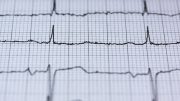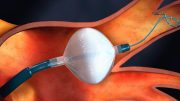
Supermarket carts embedded with electrocardiogram (ECG) sensors were utilized in a research study, SHOPS-AF, to detect atrial fibrillation in shoppers, potentially helping to prevent debilitating or fatal strokes.
The SHOPS-AF study used supermarket carts fitted with ECG sensors to detect atrial fibrillation among shoppers in a novel public health initiative. While the method demonstrated a significant number of false positives and negatives, it identified 39 previously undiagnosed cases, prompting refinements for larger-scale trials.
It could be the shopping trip that saves your life: supermarket carts are helping to diagnose atrial fibrillation which can then be treated to prevent disabling or fatal strokes. The research is presented today (June 23) at ACNAP 2023, a scientific congress of the European Society of Cardiology (ESC).[1]
“This study shows the potential of taking health checks to the masses without disrupting daily routines,” said study author Professor Ian Jones of Liverpool John Moores University, UK. “Over the course of two months, we identified 39 patients who were unaware that they had atrial fibrillation. That’s 39 people at greater risk of stroke who received a cardiologist appointment.”
More than 40 million people around the world have atrial fibrillation, the most common heart rhythm disorder.[2] Atrial fibrillation increases the risk of stroke by five-fold. These strokes are often fatal or disabling. Anticoagulation substantially lowers risk, but many people only discover they have atrial fibrillation after they have a stroke.[3] Screening programs are therefore needed to identify people with the condition so they can receive preventive medication.
The SHOPS-AF study investigated whether embedding electrocardiogram (ECG) sensors into the handles of supermarket carts could effectively identify shoppers with atrial fibrillation (see photo).[4,5] Ten carts had a sensor placed in the handle and were used across four supermarkets with pharmacies in Liverpool during the two-month study.
Shoppers were asked to use a modified cart and hold the handlebar for at least 60 seconds. If the sensor did not detect an irregular heartbeat, it lit up green. These participants had a manual pulse check by a researcher to confirm there was no atrial fibrillation. If an irregular heartbeat was found, the sensor lit up red. The in-store pharmacist then did a manual pulse check and another sensor reading using a standalone bar not attached to a trolley with the participant standing still. The study cardiologist reviewed the ECG recordings of participants with a red light and/or irregular pulse. Participants were informed of the results, which were: 1) no atrial fibrillation; 2) unclear ECG and an invitation to repeat the measurement; or 3) atrial fibrillation confirmed and a cardiologist appointment within two weeks.
A total of 2,155 adults used a shopping cart. ECG data were available for 220 participants who either had a red light on the sensor and/or an irregular pulse, suggesting atrial fibrillation. After ECG review by the study cardiologist, there was no evidence of atrial fibrillation in 115 participants, 46 recordings were unclear, and atrial fibrillation was diagnosed in 59 participants. The average age of the 59 participants with atrial fibrillation was 74 years and 43% were women. Of those, 20 already knew they had atrial fibrillation and 39 were previously undiagnosed.
To assess the accuracy of screening using this method, the researchers conducted three analyses: 1) excluding all 46 unclear ECGs; 2) assuming all unclear ECGs were atrial fibrillation; and 3) assuming all unclear ECGs were not atrial fibrillation. This showed that the sensor’s sensitivity ranged from 0.70 to 0.93 and specificity ranged from 0.15 to 0.97. This resulted in a positive predictive value of 0.24 to 0.56, meaning that only one-quarter to one-half of those found to have atrial fibrillation according to the sensor and/or manual pulse check actually had the condition (i.e. there were a high number of false positives). The negative predictive value was 0.55 to 1.00, meaning that around half of actual atrial fibrillation cases would be missed using this method (i.e. false negatives).
Professor Jones said: “Nearly two-thirds of the shoppers we approached were happy to use a cart, and the vast majority of those who declined were in a rush rather than wary of being monitored. This shows that the concept is acceptable to most people and worth testing in a larger study. Before we conduct SHOPS-AF II, some adjustments are needed to make the system more accurate. For example, having a designated position on the bar to hold onto, as hand movement interfered with the readings. In addition, ESC Guidelines require just a 30 second ECG to diagnose atrial fibrillation,[2] so we aim to find a sensor that will halve the time shoppers need to continuously hold the bar.”
He concluded: “Checking for atrial fibrillation while people do their regular shopping holds promise for preventing strokes and saving lives. A crucial aspect is providing immediate access to a health professional who can explain the findings and refer patients on for confirmatory tests and medication if needed.”
References and notes
- The abstract ‘SHOPS-AF’ will be presented during the session ‘Care of the patient beyond the hospital’ which takes place on 23 June at 15:30 CEST in the ACNAP Scientific Corner.
- “2020 ESC Guidelines for the diagnosis and management of atrial fibrillation developed in collaboration with the European Association for Cardio-Thoracic Surgery (EACTS): The Task Force for the diagnosis and management of atrial fibrillation of the European Society of Cardiology (ESC) Developed with the special contribution of the European Heart Rhythm Association (EHRA) of the ESC” by Gerhard Hindricks, Tatjana Potpara, Nikolaos Dagres, Elena Arbelo, Jeroen J Bax, Carina Blomström-Lundqvist, Giuseppe Boriani, Manuel Castella, Gheorghe-Andrei Dan, Polychronis E Dilaveris, Laurent Fauchier, Gerasimos Filippatos, Jonathan M Kalman, Mark La Meir, Deirdre A Lane, Jean-Pierre Lebeau, Maddalena Lettino, Gregory Y H Lip, Fausto J Pinto, G Neil Thomas, Marco Valgimigli, Isabelle C Van Gelder, Bart P Van Putte, Caroline L Watkins and ESC Scientific Document Group, 29 August 2020, European Heart Journal.
DOI: 10.1093/eurheartj/ehaa612 - “Stroke in atrial fibrillation: Review of risk stratification and preventive therapy” by Abdullah M. Alshehri, May-August 2019, Journal of Family and Community Medicine.
DOI: 10.4103/jfcm.JFCM_99_18 - “Supermarket/hypermarket opportunistic screening for atrial fibrillation (SHOPS-AF): a mixed methods feasibility study protocol” by Ian D. Jones, Deirdre A. Lane, Robyn R. Lotto, David Oxborough, Lis Neubeck, Peter E. Penson, Gabriela Czanner, Andy Shaw, Emma Johnston Smith, Aimeris Santos, Emily E. McGinn, Aderonke Ajiboye, Nicola Town and Gregory Y. H. Lip, 4 April 2022, Journal of Personalized Medicine.
DOI: 10.3390/jpm12040578 - The study used a MyDiagnostick single lead ECG sensor.









Be the first to comment on "The Shopping Trip That Saves Your Life: Supermarket Carts That Diagnose Heart Problems"